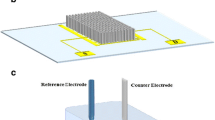Abstract
A field effect transistor (FET)-based glucose sensor was fabricated. As a totally synthetic and thus stable glucose-sensing moiety, 3-acrylamidophenylboronic acid was chemically introduced onto the FET gate surface in the form of a thin copolymer gel layer. Excellent transistor characteristics were confirmed even after the surface modification, ensuring validity of the modification procedure herein developed. Glucose-induced changes in the FET’s electric characteristics were obtained in quantitative as well as reversible manners. It was also demonstrated that the prepared FET is able to continuously perceive the change in the glucose concentration in the milieu. The detected signals were attributed to the faction change of the gate-introduced phenyborate anions, also presumably involving other parameter changes such as permittivity and conductivity. The use of the fabricated FET could further be extended to the construction of stable, readily minutualizable, and label-free carbohydrate molecule-sensing systems.






Similar content being viewed by others
References
Feng CL, Xu YH, Song LM (2000) Sens Actuators B 66:190
Schafoort RBM, Kooyman RPH, Bergveld P, Greve J (1990) Biosens Bioelectron 5:103
Kamahori M, Ishige Y, Shimada M (2007) Biosens Bioelectron 22:3080
Fritz J, Cooper EB, Gaudet S, Sorger PK, Manails SR (2002) Proc Natl Acad Sci USA 99:14142
Pouthas F, Gentil C, Cote D, Bockelmann U (2004) Appl Phys Lett 84:1594
Sakata T, Miyahara Y (2007) Biosens Bioelectron 22:1311
Sakata T, Miyahara Y (2006) Angew Chem Int Ed 45:2225
Wilson GS, Hu Y (2000) Chem Rev 100:2693
Weith H, Wiebers J, Gilham P (1970) Biochem 9:4396
Hageman JH, Kuehn GD (1997) Anal Biochem 80:547
Gelijkens C, Deleenheer A (1980) J Chrom 183:78
James TD, Sandanayake KRAS, Shinkai S (1995) Nature 374:345
James TD, Sandanayake KRAS, Iguchi R, Shinkai S (1995) J Am Chem Soc 117:8982
Nakayama D, Takeoka Y, Watanabe M, Kataoka K (2003) Angew Chem Int Ed 42:4197
Asher SA, Alexeev VL, Goponenko AV, Sharma AC, Lednev IK, Wilcox CA, Finegold DN (2003) J Am Chem Soc 125:3322
Kitano S, Kataoka K, Koyama K, Okano T, Sakurai Y (1991) Makromol Chem Rapid Commun 12:227
Kitano S, Koyama K, Kataoka K, Okano T, Sakurai Y (1992) J Control Release 19:161
Kataoka K, Miyazki H, Bunya M, Okano T, Sakurai Y (1998) J Am Chem Soc 120:12694
Matsumoto A, Kurata T, Shiino D, Murata Y, Kataoka K (2004) Macromolecules 37:1502
Matsumoto A, Yoshida R, Kataoka K (2004) Biomacromolecules 5:1038
Miyazaki H, Kikuchi A, Koyama Y, Okano T, Sakurai Y, Kataoka K (1993) Biochem Biophys Res Commun 195:829
Uchimura E, Otsuka H, Okano T, Sakurai Y, Kataoka K (2000) Biotechnol Bioeng 72:307
Shoji E, Freund M (2002) J Am Chem Soc 124:12486
Zayats M, Katz E, Willner I (2002) J Am Chem Soc 124:2120
Kikuchi A, Suzuki K, Okabayashi O, Hoshino H, Kataoka K, Sakurai Y, Okano T (1996) Anal Chem 68:823
Gabai R, Sallacan N, Chegel V, Bourenko T, Katz E, Willner I (2001) J Phys Chem B 105:8196
Otsuka H, Uchimura E, Koshino H, Okano T, Kataoka K (2003) J Am Chem Soc 125:3493 (references are therein)
Tanaka T (1978) Phys Rev Lett 40:820
Hirotsu S, Hirokawa Y, Tanaka T (1987) J Chem Phys 87:1392
Acknowledgment
We thank Dr. C. Kataoka (National Institute for Materials Science), Drs. M. Washizu, K. Ishihara, and R. Yoshida (The University of Tokyo) for their help and useful discussion.
Author information
Authors and Affiliations
Corresponding author
Rights and permissions
About this article
Cite this article
Matsumoto, A., Sato, N., Sakata, T. et al. Glucose-sensitive field effect transistor using totally synthetic compounds. J Solid State Electrochem 13, 165–170 (2009). https://doi.org/10.1007/s10008-008-0610-7
Received:
Revised:
Accepted:
Published:
Issue Date:
DOI: https://doi.org/10.1007/s10008-008-0610-7




